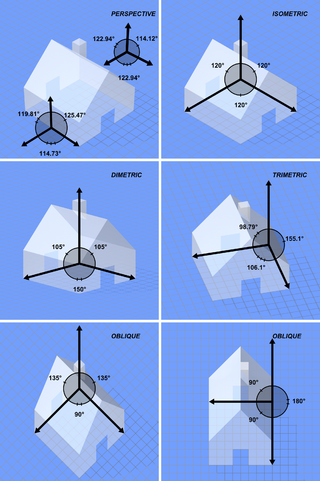Isometric 3D
This page is intended to complete the Category:Isometric 3D, check the categories at the bottom of this page to get more related links.
It will feature technics in creating Isometric 3D and graphics.
Isometric 3D is a representation of 3D with a total lack of perspective.
The proper concept is actually Parallel Projection, as some games are are sometime using other parallelprojections than isometric.
Pac-Mania for exemple is not really "isometric" but actually "Oblique".
Yet the term Isometric is the most commonly used, as it suit for most of those pseudo 3D games, so we'll use it as a whole, despite sometimes unproperly.
Contents
Types of pseudo 3D
The global term is parallel projection.
Used parellel projections are often :
- Horizontal Oblique projection : Pac-Mania obviously, yet "Beat Them Up" games (like Double dragon or Renegade) or even few "Shoot them Up"s (Mag Max) do use some kind of this.
- In those case, we can talk about Perspective Cavalière (F) / Kavalierperspektive (D) / Perspectiva caballera (E) (is there en English equivalent) which is a perspective with unchanged 2D vertical and horizontal and a 3rd Axis in oblique. This specific projection enable to keep the 2D gameplay based on vertical and horizontal movement.
- Isometric projection : Head Over Heels is the most well known.
- Backgrounds or graphics in such projection are easily obtained in Mode0 as it need an oblique matrix with a scale of 1vertical for 2 horizontal. Sadly the blocky pixels of Mode0 don't enable to do finely detailed sprites
- Sadly this kind of projection bring some problems concerning the diagonals and control as we'll see later.
- Oblique 135°/135°/92° projection :It is some sort of Mode1 isometric. In this, the ratio for the diagonal grid is 1 for 1. This was sometimes used in some Speccy originated games as this enable to put more tiles or elements on the horizontally limited Speccy resolution
- Example : W*H*B, a modern Bloxorz' Clone on ZXSpectrum.
- A More CPC oriented example game is probably Frontiers (Zafiro Software (1988)).
Masked Sprites and Elements
A proper isometric render need to get masked sprites so they may appear upon the background.
Also some Elements which are to be put in front of sprites also have to be masked.
A heavy job is needed to define the masks and sprites "priority" so the 3D effect works : the background elements being obscured by the foreground elements.
Shadows
Getting the sprites a shadow is a nice way to ease the player's comprehension of the 3D effect and environment, yet it was rarely used.
Head over Heels is notable because when your Sprite (mostly "Head" who could glide in the air) was in "altitude" you may not easily see were it is actually in the X,Z plane.
Yet putting a vertical shadow was heavier on the CPU and Ram consuming...
Video modes
The square pixels from Mode1 was usually prefered for real Isometric.
Yet games in mode 0 managed well with it or other parallel projections type too.
Some reasons the Mode1 was anyway quite popular :
- Many isometric games were Speccy Ports.
- the fine square pixels in mode1 also enable to get fine detailed sprites, while the blockier Mode0 would need those sprites to be bigger in order to manage a proper level of details.
HUD
a problem with Isometric was the need to put HUD in corners of the screen. As a result, it was rarely possible to add extra colours thanks to raster interrupts because the HUD often cross the games windows (horizontally).
Scrollings
Few Isometric games actually included scrollings as an Isometric engine is quite heavy for the system.
A proper scrolled isometric game would need 2 diagonal scrolings and perhaps a vertical scrolling too.
Not the easiest to get.
Yet Pac-Mania is a notable exemple of scrolled parallel projection game, its Oblique projection being more suitable for scrollings as it need only 1 diagonal scrolling and 1 horizontal scrolling.
Pixel Art
Isometric is often used in classic Pixel Art and is emblematic of it as it was the best way to display good looking pseudo 3D FX on old computer 2D systems.
(in opposition to the modern full-real-3D).
Level design
The background elements being obscured by the foreground elements, a proper level design is needed so most crucial elements remain visible.
Yet this can also used to put hidden features and secret passages too.
Modern day isometric
Isometric 3D is still used in modern day, mostly to get the old-styled Pixel Art flavour.
Online MMORPG "Dofus" is notable for it's use of isometric 3D.
"Habbo Hotel" is also a well known modern exemple.
Links
Wikipedias articles :

